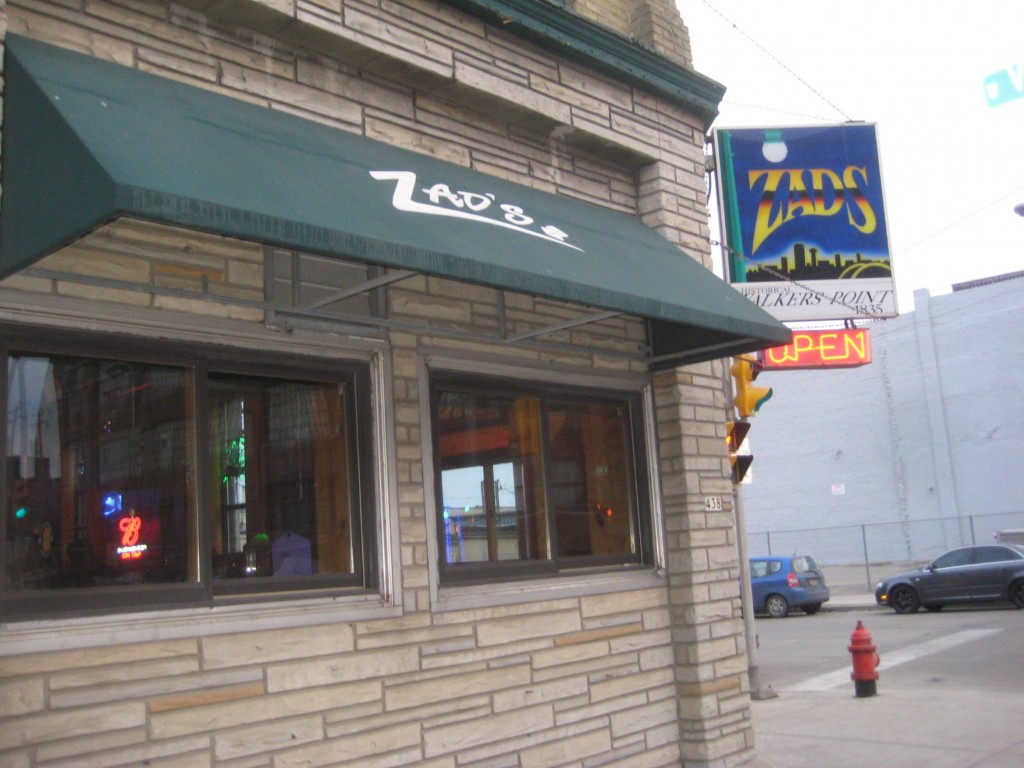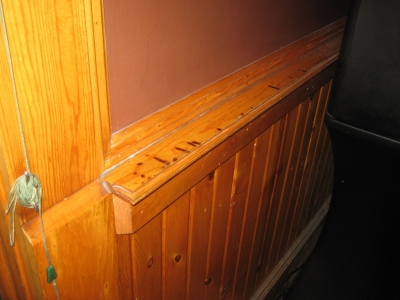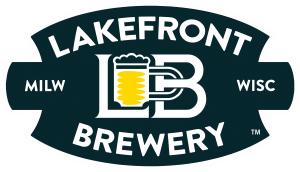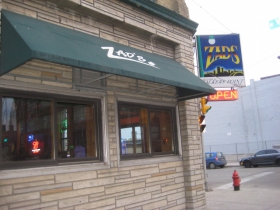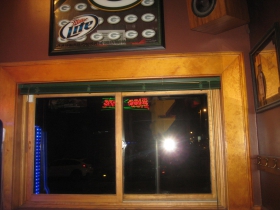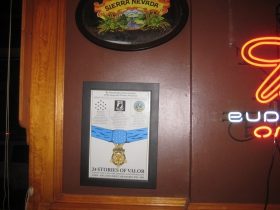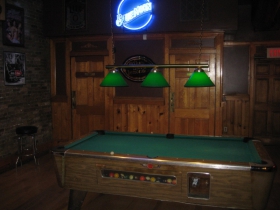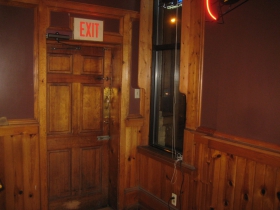Zad’s Is a Relic of Old Milwaukee
Working-class bar with more than a century of history still opens at 6 a.m. You can feel the ghosts of its rooming-house era.
“You can’t drink all day unless you start in the morning,” the saying goes, and you can’t get a much earlier start on your drinking than at Zad’s, which opens its doors to the thirsty every morning at 6 a.m. It also sells T-Shirts with this alluring slogan from behind the bar.
The hyper-early tavern hours are a relic of Milwaukee’s industrial heritage, when factories operated around the clock, discharging thirsty laborers every 8 – 12 hours or so. For a third shifter, 6 a.m. was every bit as much a happy hour as was 6 p.m. to the banker.
Terry Zadra, who has owned this place for a quarter century, remembers those days. He told a Reuters reporter in 2012, “I used to get the third-shift Allen Bradley guys in the morning, but they have cut and cut jobs.”
There can be no doubt that the working class immigrant was the focus of this 1887 building at the time it was built. After finishing their shift (of work or drinking) many customers faced a vertical commute to the rooming house that occupied the building’s top two floors. There were 16 rooms above, according to a 1934 survey, ranging from a cozy 8′-11″ x 8′-4″ unit to a baronial 10′-10″ x 14′-0″ suite. Many units lacked closets, but then again, many blue collar workers lacked a change of clothes, so the loss was not noted. One bath tub served the needs of all the residents, which may have been minimal. There were also 2 toilets in the rooming house portion — one per floor.
In 1961, a room above the tavern would set you back $7 a week. Those were the days.
But in its original iteration, an 18′ x 17′ wood wainscoted room to the east of that served as the “Ladies Room,” which is a misleading term by today’s standards. No, the women did not have a 300 square foot “powder room” — their bathroom was 4′ x 4′ and tucked under the staircase, opposite the men’s. The “ladies room,” in this context, referred to where women were permitted in the establishment, easily accessible from the back door. Just to the east of the Ladies Room was a 12′ x 17′ kitchen, where, it goes without saying, women were also permitted. There was a women’s toilet, as well, beneath the staircase, accessed off that lovely ladies room.
The building dates to 1887, according to city records, but no documentation of it appears until 1905 when Math. Pereles & Son., a real estate firm, and presumably the landlord, took out a permit to alter the storefront at what was then 226 Reed St. Small windows, likely similar to those still extant on the building’s south facade, were replaced by large storefront windows to display the wares of H. Siegel, Grocer.
Siegel’s vinegar, produced by Roundy, Peckham & Co. (the operators of today’s Pick ‘n Save stores) had acidity of 3.7%, the report found. “Deficient in acetic acid. Not lawfully stenciled.”
By 1915 the building was licensed to Frank Fuzer by the Common Council of the City of Milwaukee for the purpose of selling “vinous, spiritous, malt, ardent or intoxicating liquors or drinks.” There were 27 taverns then in a four block stretch of the street, almost all bearing names of German owners.
The building then falls into the twilight of the Prohibition Era except for 1925 when Joseph Levar erected a 20′ x 30′ garage in the rear of the building just to the north, a two story affair at 434 S. 2nd St. that has since been merged with the corner building.
With the dawn of Repeal, Jack Gostechnik wasted no time in 1934 applying for a certificate of occupancy for the tavern, leaving blank the line asking for the building’s previous use. I think we know what that use was, if history is any guide.
Gostechnik was born in “Jugoslavia” in 1887, and by the time he rolled onto the scene, many of his counterparts from Slovenia opened bars on the busy stretch of street. “Tony’s Tavern,” (long run by Tony Pogorelc) remains on the block, but is vacant, although furnished. The owner has been dead for years; his wife was born in the place. Bachun’s Tap, also located on the block, remained a remarkable time capsule. In 1993 I wrote a story in Milwaukee Magazine entitled “Aged Spirit” about Agnes Bachun, still tending bar into her 90’s.
Gostechnik had a pretty good run in his tavern/rooming house, lasting until about 1955 when Curt Verish opened it as the Commerce Bar Tavern. In 1960, the place was “Curt and Mousie’s Tap,” which is a mighty fine bar name, lasting until 1964 when it became “Botch’s,” which is a perfectly horrible bar name.
Kurt Schnittke ran it as “Kurt’s Bar” in 1970, and in 1975 it became Ted’s Swing Room, operated by Ted Modrow. In 1980, the place was renamed Del’s Swing Inn, as it remained until 1990 when the tavern took its new name of Zad’s after it was purchased by the current owner, Terry Zadra, in 1989 for $268,000. The price included the building next door at 434 S. 2nd St., which is now known as Zad’s Roadhouse, and is only intermittently open for special events.
Along the way, the corner bar went through its changes. The large storefront windows installed in 1905 were pulled out in 1958 and replaced with the ones still visible today on S. 2nd St. (The W. Virginia St. facade has mercifully remained unaltered over the past 125 years, and has some excellent brickwork details.)
“Windows will be smaller size, so openings around windows will have to be of non-combustible material,” the building inspector warned, ordering the owner to “apply permastone to front wall.” The year before, a new boiler was installed next door — new to the building, that is. “Used boiler moved from 742 N. 16th St.,” the inspector noted.
In 1964, Botch’s put up a Blatz sign, which was replaced by a Pabst sign in 1972.
Big, yet overall sensitive interior changes were underway in 1976. The ladies toilet moved out from under the stairs, and now was located next to the expanded men’s toilet on the east wall. It is likely that much of the knotty pine wainscoting found in the place today dates from that time. It appears the remodelers saved and reused much of the original trim, since it is of far higher quality, and likely much greater age, than the pine.
There was a minor fire in the bar in 1969 that caused $200 in damages. On September 3rd, 1977 a fire caused $10,000 in damages to the rooming house upstairs. It was followed on January 7th, 1978 by yet another fire in the “3-story masonry tavern & rooming house. Repair 3rd floor wall & ceilings. $15,000,” the inspector ordered.
By that period of the city’s history, the industrial jobs that had sustained the old neighborhood were beginning to disappear, and the neighborhood itself was getting a bit shaky. In May 1978, the most recent fire damage was repaired. “Property had been vacant with numerous operators,” the assessor noted.
In 1989, the masonry walls between the corner building and the one to the north were cut through on the first and second floors. The tavern, now 55′ x 18′ after the bathroom remodeling and the separation of the old ladies room and kitchen into a separate apartment, was granted a legal capacity of 25 customers. An attempt was made to occupy the upper floor as part of the rooming house in 1989, but the city vetoed that plan and ordered access to the second floor to be sealed.
The next year, carpenters changed the door on the tavern to swing outward, increasing the capacity to 80, where it remains today. Upstairs, only 15 of the 16 rooms were licensed to be occupied. In 2000, the rooming house was converted into four apartments.
Today Zad’s is a place you can count on to be open, what with the 6 a.m. starting time, and it is still easy to feel the ghosts of the rooming house era about on the old block — just up the street, Shakers, 422 S. 2nd St., runs a series of ghost tours of its building.
Zad’s is fortunate to have retained its original high ceiling, powered by a couple of fans beneath the painted wood. But the brick walls, maple floors, well-proportioned windows [south] and other original interior details deserve better than the dozens of tacky beer and liquor signs that are the only decorations in the entire place, with the exception of a certificate thanking the bar for its support of the military. I’m not asking Zad to hang ferns in the bright, sunny windows, but perhaps a few historic photos of, say, the fabulous Milwaukee Fire Department Engine #3 building, located next door at 100 W. Virginia St., would attract a newer audience to the place on the newly vibrant S. 2nd St., and give the regulars something different to look at.

There is a refrigerator along the bar, as well as two pizza ovens which get a considerable workout. Photo by Michael Horne.
There are three bump-out tables for customers who might to look out the windows while seated on circular, padded, backless stools. You can sit at the west window and savor your drink while looking at the old Soref’s Carpet City building across the street. The bar itself, on the north wall, has a dozen fixed, padded, hard-backed chairs. It has a wood-grained formica top suggesting a date in the 1970s, and oak coolers behind, suggesting a much earlier date. High on the south wall is a Smoke-eeter, a ventilation relic that is unneeded in the smoke-free tavern era. There is a refrigerator along the bar, as well as two pizza ovens which get a considerable workout.
A hint of earlier days, when the place would catch fire every now and then, can be found on the window ledge by the pool table. The ledge shows many cigarette burns. There is a jukebox for your entertainment, but on a recent visit, the music was mercifully set to WMSE 91.7FM, and the images on the three flat screen televisions were silent. Customers, including one who has lived in the area for over half-a-century, talked about old times and new.
On Tap - Sponsored by Lakefront Brewery
- Lakefront Brewery IPA
- Lakefront Brewery Riverwest Stein
- Miller High Life
- Miller Lite
- Milwaukee Brewing Co. Louie's Demise
- Milwaukee Brewing Co. Outboard Cream Ale
- Milwaukee Brewing Co. Pull Chain
- New Glarus Spotted Cow
Photo Gallery
The Verdict:
- Location: 436-438 S. 2nd St. [Zad’s]; 434 S. 2nd St. [Zad’s Roadhouse]
- Neighborhood: Walker’s Point
- Subdivision: None
- Phone number:
- Website: None found
- Facebook: None found
- Twitter: None found
- Description: Old tavern was built near original train station in heart of Milwaukee’s early industrial district. Been serving drinks at least for a century under many operators. Rooming house above operated for over a century, now apartments. Bar has nice proportions and many original details. Still draws a working- class crowd, but is also a stop on pedal tavern route. Has not quite embraced the new upscale Walker’s Point ethos. Open every day at 6 a.m.
- Food: About 15 per cent of the business here is food, with frozen pizza the focus.
- Signature Drink: Whatever your body absolutely craves at 6 a.m..
- Capacity: 80 in 1,269 square-foot tavern built in 1887.
- Restrooms: Women’s, men’s rooms. Men’s toilet still partially beneath staircase. Watch your head!
- Year Established: Tavern since at least 1915, possibly before. Apparently a grocer in 1905, but may have been a tavern before. Taverns beneath rooming houses were very common in the area. Terry Zadra operates under current name for over 25 years. Bought building and one next door in 1996.
- Year Building Constructed: 438 S. 2nd was built in 1887 with 16 rooms above; 434 S. 2nd St was built in 1890. Buildings joined 1989.
- Estimated Annual Rent: Zad’s at 438 S. 2nd St. is 1,269 square feet at $19.88 per square foot annual rent for a total of $25,227. Zad’s Roadhouse at 434 S. 2nd St. is 1,520 s.f. at $16.83 s.f. annual rent for a total of $25,581 according to city estimates. Property at 438 S. 2nd St. assessed at $16,000 for the 2,000 square foot lot [$8.00/s.f.] and $355,000 for the 6,178 sq. ft. building for a total assessed valuation of $371,000. Taxes are $11,105.51 and are paid in full. Building at 434 S. 2nd St. assessed at $24,000 for the 3,000 square foot lot [$8.00/s.f.] and 269,000 for the 2,840 s.f. building for a total assessed valuation of $293,000. Taxes are $8,869.01 and are paid in full. Operator owns building.
- Walk Score: 85 out of 100, “Very Walkable.” Rating will doubtless increase with growing retail options in area, including Cermak grocery planned for E. Greenfield Ave. to the south.
- Transit Score 59 out of 100, “Good Transit”. Blue, Green, 15, 19, 23 bus lines all within a block.
- Games of Chance: None.
- Games of Skill: A nice pool table at the east end of the bar near the bathrooms.
- Aldermanic District: 12th Jose Perez
- Trade Name : Zad’s, Zad’s Roadhouse
- Police District: 2
Hours of Operation
| Is Open? | Day | Open | Close | Expected Customers | Age Restriction |
|---|---|---|---|---|---|
| True | Sun | 6:00AM | 2:00AM | 100 | |
| True | Mon | 6:00AM | 2:00AM | 75 | |
| True | Tue | 6:00AM | 2:00AM | 70 | |
| True | Wed | 6:00AM | 2:00AM | 90 | |
| True | Thu | 6:00AM | 2:00AM | 100 | |
| True | Fri | 6:00AM | 2:30AM | 150 | |
| True | Sat | 6:00AM | 2:30AM | 150 |
If you think stories like this are important, become a member of Urban Milwaukee and help support real, independent journalism. Plus you get some cool added benefits.
Bar Exam
-
Lakefront Brewery’s New Riverwalk Patio
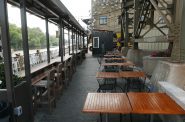 Jul 26th, 2023 by Michael Horne
Jul 26th, 2023 by Michael Horne
-
How Falcon Bowl Was Saved
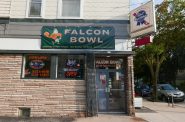 Jul 12th, 2023 by Michael Horne
Jul 12th, 2023 by Michael Horne
-
Clementines Evokes the New Bay View
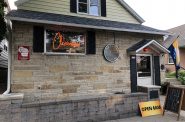 Sep 19th, 2022 by Michael Horne
Sep 19th, 2022 by Michael Horne


